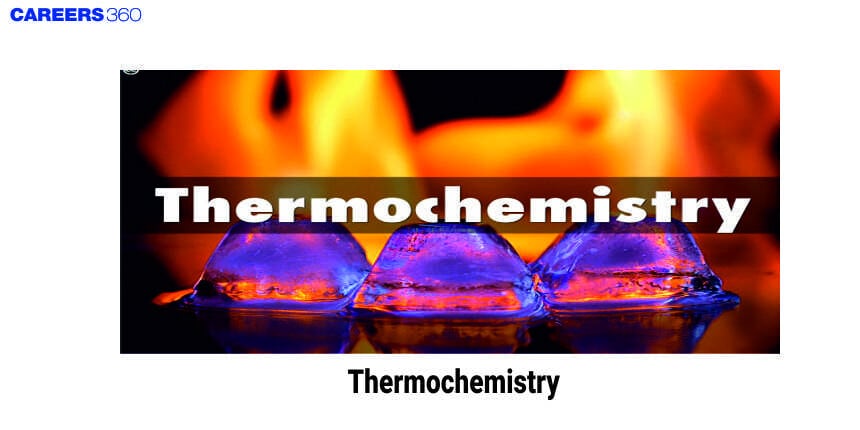Thermochemistry
Thermochemistry deals with heat and energies associated with different physical transformations and chemical reactions. Energy is either absorbed during an endothermic reaction, or it can be released, exothermic. The main concern of thermochemistry, however, is the change in energy, usually regarding the exchange of energy of a system with its surroundings.

The laws of thermodynamics tell us that the energy of an isolated system is constant. If it is not an isolated system, then, in any chemical reaction, the energy remains conserved. Thermochemistry helps in understanding energy change, heat change, and spontaneity of reactions. All reactions share a common factor of heat, work, and heat-work relationship. In a reaction, the work can be done on the system or the work can be done by the system. Similarly, heat can either be absorbed or heat given out of the system. A study of all these also helps in determining the actual energy available in food.
Thermochemistry
It deals with the heat changes during chemical reactions. It is called chemical energetics and is based on the first law of thermodynamics.
Exothermic Reaction
Heat is evolved here.
$\Delta \mathrm{H}$ is -ve as $\mathrm{H}_{\mathrm{R}}>\mathrm{H}_{\mathrm{P}}$
$\Delta \mathrm{H}=\mathrm{H}_{\mathrm{P}}-\mathrm{H}_{\mathrm{R}}=-$ ve (at constant pressure)
At constant volume, $\Delta \mathrm{E}=\left(\mathrm{E}_{\mathrm{P}}-\mathrm{E}_{\mathrm{R}}\right)=-\mathrm{ve}$ that is. $\mathrm{E}_{\mathrm{R}}>\mathrm{E}_{\mathrm{P}}$
Endothermic Reaction
Here heat is absorbed.
$\Delta H$ or $\Delta E=+$ ve for endothermic $\Delta H=H_p-H_R=+$ ve ( at constant pressure as ) as $H_p>H_R$ or $E_p>E_R$
At constant volume
$$
\Delta E=\left(E_p-E_R\right)=+v e
$$
Heat or Enthalpy of Reaction
It is the change in enthalpy (amount of heat evolved or absorbed) when the number of gm-moles of the substance indicated by a chemical reaction has undergone a complete reaction.
It is determined by water and Bomb calorimeters Mathematically, it is given as
$
=\Sigma \mathrm{H}_{\mathrm{p}}-\Sigma \mathrm{H}_{\mathrm{R}}
$
It can be express by $[\Delta \mathrm{H}]_{\mathrm{p}}$ or $[\Delta \mathrm{E}]_{\mathrm{v}}$ at constant pressure and volume respectively.
Some Solved Examples
Example 1: When combustion of ethylene ( C2H4) takes place it releases carbon dioxide and water. If the enthalpy of formation of C2H4 is$w$, for $\mathrm{O}_2$ is $x$, for $\mathrm{CO}_2$ is $y$ and for $\mathrm{H}_2 \mathrm{O}_{\text {is }} z$.z. Then find the enthalpy of the reaction:
1) $y+z-w-x$
2) $W+3 x-2 y-2 z$
3) $2 y+2 z-w-3 x$
4)All of the above
Solution:
Enthalpy of reaction, $\Delta H=H_P-H_R$
First, write the balanced equation of the reaction
$\mathrm{C}_2 \mathrm{H}_4+3 \mathrm{O}_2 \rightarrow 2 \mathrm{CO}_2+2 \mathrm{H}_2 \mathrm{O}$
Given:
$
\begin{aligned}
& \Delta H_f^0 C_2 H_4=w \\
& \Delta H_f^0 O_2=x \\
& \Delta H_f^0 C O_2=y \\
& \Delta H_f^0 H_2 O=z
\end{aligned}
$
Now, $\Delta H=(2 y+2 z)-(w+3 x)=2 y+2 z-w-3 x$
Example 2: When combustion of Methane (CH4 ) takes place it releases carbon dioxide and water. If the enthalpy of formation of CH4 is 10J, for O2 us OJ, for CO2 us 5J and for H2O us 3J and only 50% CH4 is converted then the enthalpy of reaction and nature of the reaction is:
1)-0.5J, Exothermic
2) +0.5J, Endothermic
3)-1J, Exothermic
4)+1J, Endothermic
Solution:
Enthalpy of reaction, $\Delta H=H_P-H_R$
First, write the balanced equation of the reaction
$\mathrm{CH}_4+2 \mathrm{O}_2 \rightarrow \mathrm{CO}_2+2 \mathrm{H}_2 \mathrm{O}$
$\begin{aligned} & \Delta H_f^0 C H_4=10 \mathrm{~J} \\ & \Delta H_f^0 O_2=0 \mathrm{~J} \\ & \Delta H_f^0 C O_2=5 \mathrm{~J} \\ & \Delta H_f^0 H_2 O=3 \mathrm{~J}\end{aligned}$
As the conversion is only 50% then all reactants and products will also be converted 50%.
So,$\Delta H=5 \times 0.5+2 \times 3 \times 0.5-0-10 \times 0.5=2.5+3-5=+0.5 \mathrm{~J}$
Hence it is an endothermic process
Example 3: If $\Delta H$ is the change in enthalpy and $\Delta E$ the change in internal energy accompanying a gaseous reaction, then
1) $\Delta H$is always greater than $\Delta E$
2)$\Delta H<\Delta E$ only if the number of moles of the products is greater than the number of the reactants
3)$\Delta H$ is always less than $\Delta H$
4) $\Delta H<\Delta E$ only if the number of moles of the products is less than the number of the reactants
Solution:
We know this formula
$\Delta \mathrm{H}=\Delta \mathrm{E}-\Delta \mathrm{ng}_{\mathrm{g}} R \mathrm{TT}$
From the above formula only possible statement -
$\Delta H<\Delta E$$\Delta H<\Delta E$ only if the number of moles of the products is less than the number of the reactants.
And rest statements are incorrect.
Example 4: For which of the following reactions, $\Delta \mathrm{E}=\Delta \mathrm{H}$ ?
$\begin{aligned} & \text { 1) } \mathrm{N}_2 \mathrm{O}_4(\mathrm{~g}) \rightleftharpoons 2 \mathrm{NO}_2(\mathrm{~g}) \\ & \text { 2) } 2 \mathrm{SO}_2(\mathrm{~g})+\mathrm{O}_2(\mathrm{~g}) \rightleftharpoons 2 \mathrm{SO}_3(\mathrm{~g}) \\ & \text { 3) } \mathrm{H}_2(\mathrm{~g})+\mathrm{I}_2(\mathrm{~g}) \rightleftharpoons 2 \mathrm{HI}(\mathrm{g}) \\ & \text { 4) } 2 \mathrm{H}_2(\mathrm{~g})+\mathrm{O}_2(\mathrm{~g}) \rightleftharpoons 2 \mathrm{H}_2 \mathrm{O}(\mathrm{l})\end{aligned}$
Solution:
$
\begin{aligned}
& \Delta H=\Delta E+(\Delta n) R T \\
& \Delta H=\Delta E \text { when } \Delta n=0
\end{aligned}
$
Out of the given reactions, $\Delta \mathrm{n}=0$ for
$
\mathrm{H}_2(\mathrm{~g})+\mathrm{I}_2(\mathrm{~g}) \rightleftharpoons 2 \mathrm{HI}(\mathrm{g})
$
Summary
In thermodynamics, the system refers to that 'part' which is under study. The 'part' of the universe excluding the system is called the surroundings. A boundary separates the system and surroundings. For example, while a student does the inorganic salt analysis, salt becomes a system while the container and the laboratory become the surroundings and walls of the container biome the boundary.Thermochemistry involves the heat energy associated with chemical reactions and physical state changes, the basic principles of which are founded upon the First Law of Thermodynamics: energy is conserved. Major terms to be noted are enthalpy, H, and enthalpy change, ΔH. Exothermic reactions are those in which heat is given off (negative ΔH), whereas in an endothermic reaction, heat is taken in (positive ΔH). Calorimetry is used for the measurement of the heat exchanged in a reaction.
Frequently Asked Questions (FAQs)
Also Read
05 Aug'25 12:15 PM
31 Jul'25 02:08 PM
02 Jul'25 08:10 PM
02 Jul'25 08:05 PM
02 Jul'25 08:05 PM
02 Jul'25 06:32 PM
02 Jul'25 06:31 PM
02 Jul'25 06:31 PM
02 Jul'25 06:31 PM
02 Jul'25 06:31 PM
